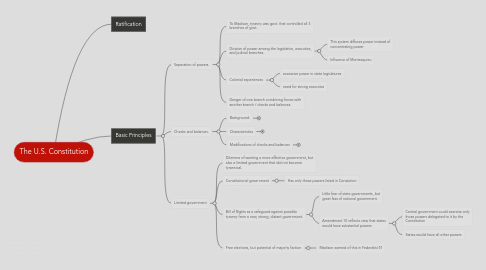
1. Ratification
2. Basic Principles
2.1. Separation of powers.
2.1.1. To Madison, tyranny was govt. that controlled all 3 branches of govt.
2.1.2. Division of power among the legislative, executive, and judicial branches.
2.1.2.1. This system diffuses power instead of concentrating power
2.1.2.2. Influence of Montesquieu
2.1.3. Colonial experiences
2.1.3.1. excessive power in state legislatures
2.1.3.2. need for strong executive
2.1.4. Danger of one branch combining forces with another branch / checks and balances.
2.2. Checks and balances.
2.2.1. Background.
2.2.1.1. 18th century view of govt. as something to be restrained, and modern view of govt. as something to be used for the common good.
2.2.1.2. Fear of tyranny among Founders ---> distrust of govt. ---> checks and balances as means of intentionally building inefficiency in order to prevent govt. abuse of power.
2.2.2. Characteristics
2.2.2.1. System of restraints in which each branch can check the other two. Reflects fear of tyranny.
2.2.2.1.1. Examples: veto, veto override, appointment and confirmation, treaty-making and ratification, defense funding and Commander-In-Chief.
2.2.2.2. Political independence within each branch: no branch is dependent upon the other two for election (exception: judges are appt'd by President) and continuance in office (life terms for judges ameliorate presidential influence).
2.2.2.3. Staggering of terms within each branch -> a majority of voters can gain control over one part of govt. at one time, e.g., midterm cong. elections can serve as a check on the exec.
2.2.3. Modifications of checks and balances
2.2.3.1. Examine if the following strengthen or weaken checks and balances.
2.2.3.1.1. Political parties.
2.2.3.1.2. Changes in voting methods.
2.2.3.1.3. Growth of federal bureaucracy.
2.2.3.1.4. Changes in technology
2.2.3.1.5. Emergence of U.S. as world power after WWII.
2.3. Limited government
2.3.1. Dilemma of wanting a more effective government, but also a limited government that did not become tyrannical.
2.3.2. Constitutional government
2.3.2.1. Has only those powers listed in Constution
2.3.3. Bill of Rights as a safeguard against possible tyranny from a new, strong, distant government.
2.3.3.1. Little fear of state governments, but great fear of national government.
2.3.3.2. Amendment 10 reflects view that states would have substantial powers
2.3.3.2.1. Central government could exercise only those powers delegated to it by the Constitution
2.3.3.2.2. States would have all other powers
2.3.4. Free elections, but potential of majority faction
2.3.4.1. Madison warned of this in Federalist 51
